Rethinking the Impact of Land Certification on Tenure Security, Land Disputes, Land Management, and Agricultural Production: Insights from South Wello, Ethiopia
Abstract
:1. Introduction
2. Related Literature
2.1. The Concept of Tenure Security
2.2. Land Certification
2.3. Role of Tenure Security on Adoption of SWCPs
2.4. Land-Related Disputes
3. Methods
3.1. Site Description
3.2. Methods
4. Result
4.1. Socioeconomic Characteristics of the Respondents
4.2. Land Certification and Tenure Security
4.3. Land Certification and Land Disputes
Since the certificate issuance, land-based disputes have shown a declining trend. However, the problem persists in lower circumstances and magnitudes than ever before. Whenever a problem arises, the disputants try to solve the problem without the involvement of third party. If they fail to agree, the disputants take the issue to village elders. If not solved yet, the village elderlies pass the case to the Kire and then to Abagars; if the problem stays unsolved, they take it to the kebele Setita committee. Again, If the disputants still do not consider the decisions of the mentioned social platforms, they bring the case to the attention of formal institutions; kebele land administration, Woreda land administration, Woreda and higher courts. One of the critical admissible pieces of evidence the plaintiff and defendant asked to show by formal and informal institution is a certificate of the land they dispute on. By doing so, the court will rule based on the admissible evidence proven. As a result of this process, land-related disputes are gradually diminishing. Therefore, the number of person-days spent as plaintiff, defendant, witnesses, and arbitrates was reduced. Such labor force to be devoted since the onset of the dispute, which is to be expressed in terms of person-days will be dedicated to various agricultural activities to be spent on either own or other off-farm activities. Besides, certain costs pertinent to the court’s process, court costs, travel expenses, accommodation costs, process service, consultant payment, and witness fees will be utilized for the household needs. They conclude that land certification has played a pivotal role in reducing land disputes and helped them fully utilise the existing labor force in agricultural activities alone.
4.4. Land Certification Contribution towards SWCPs and Agricultural Productivity
5. Discussion
6. Conclusions, Recommendation, and Future Research
Author Contributions
Funding
Data Availability Statement
Conflicts of Interest
References
- Sivakumar, M.V.K.; Ndiang’ui, N. (Eds.) Climate and Land Degradation; Springer: Berlin/Heidelberg, Germany, 2006. [Google Scholar] [CrossRef]
- Clarke, M. Assessing Well-Being Using Hierarchical Needs; no. 2005/22; WIDER Research Paper; UNU-WIDER: Helsinki, Finland, 2005. [Google Scholar]
- Toulmin, C. Securing land and property rights in sub-Saharan Africa: The role of local institutions. Land Use Policy 2009, 26, 10–19. [Google Scholar] [CrossRef]
- Teshome, M. Population growth and cultivated land in rural Ethiopia: Land use dynamics, access, farm size, and fragmentation. Resour. Environ. 2004, 4, 148–161. [Google Scholar]
- Adugna, F. Landlessness. Land Access Modalities and Poverty in Rural Areas of Oromia National Regional State, Ethiopia. Ethiop. J. Dev. Res. 2018, 40, 33–66. [Google Scholar]
- FAO. World Food and Agriculture–Statistical Yearbook 2021; FAO: Rome, Italy, 2021. [Google Scholar] [CrossRef]
- FAO; IFAD; UNICEF; WFP; WHO. The State of Food Security and Nutrition in the World 2022. Repurposing Food and Agricultural Policies to Make Health Diets Affordable; FAO: Rome, Italy, 2022. [Google Scholar]
- Bellemare, M.F. The productivity impacts of formal and informal land rights: Evidence from Madagascar. Land Econ. 2013, 89, 272–290. [Google Scholar] [CrossRef]
- Mekuriaw, A.; Heinimann, A.; Zeleke, G.; Hurni, H. Factors influencing the adoption of physical soil and water conservation practices in the Ethiopian highlands. Int. Soil Water Conserv. Res. 2018, 6, 23–30. [Google Scholar] [CrossRef]
- Adimassu, Z.; Langan, S.; Johnston, R.; Mekuria, W.; Amede, T. Impacts of soil and water conservation practices on crop yield, run-off, soil loss and nutrient loss in Ethiopia: Review and synthesis. Environ. Manag. 2017, 59, 87–101. [Google Scholar] [CrossRef]
- Burton, J. Conflict resolution as a political philosophy. Glob. Chang. Peace Secur. 1991, 3, 62–72. [Google Scholar] [CrossRef]
- Wehrmann, B. Understanding, Preventing and Solving Land Conflicts: A Practical Guide and Toolbox; Deutsche Gesellschaft für Internationale Zusammenarbeit (GIZ) GmbH: Bonn, Germany, 2017. [Google Scholar]
- Schellenberg, J.A. Conflict Resolution: Theory, Research, and Practice; Suny Press: Albany, NY, USA, 1996. [Google Scholar]
- Kansiime, N.; Harris, G. Strengthening traditional approaches to community-level land disputes: An action research project in western Uganda. Afr. J. Confl. Resolut. 2020, 20, 59–76. [Google Scholar]
- Sekeris, P. Land inequality and conflict in sub-Saharan Africa. Peace Econ. Peace Sci. Public Policy 2011, 16, 0000102202155485971208. [Google Scholar] [CrossRef]
- Sarwar, G.; Islam, R.; Monzoor, S. Women’s Rights to Land in Bangladesh: Roles, Limitations and Transformation; Unnayan Onneshan–The Innovators: Dhaka, Bangladesh, 2007. [Google Scholar]
- Takeuchi, S. Features of land conflicts in post civil war Rwanda. Afr. Study Monogr. Suppl. Issue 2011, 42, 119–138. [Google Scholar]
- Siyum, B.A.; Kassa, B.S.B.; Gebremedhin, M.A.; Mekelle, E. Farm land conflict and its socio-economic consequences in Tahtay Qoraro, Tigray, Ethiopia. Int. J. Afr. Asian Stud. 2015, 9, 44–55. [Google Scholar]
- Ellis, F. Rural Livelihoods and Diversity in Developing Countries; Oxford University Press: Oxford, UK, 2000. [Google Scholar]
- Blau, P.M.; Duncan, O.D. The American Occupational Structure; Free Press: Florence, MA, USA, 1967. [Google Scholar]
- Zevenbergen, J. Systems of Land Registration Aspects and Effects; Netherlands Geodetic Commission: Amersfoort, The Netherlands, 2002; p. 210. [Google Scholar]
- Nigussie, S.; Liu, L.; Yeshitela, K. Towards improving food security in urban and peri-urban areas in Ethiopia through map analysis for planning. Urban For. Urban Green. 2021, 58, 126967. [Google Scholar] [CrossRef]
- Abera, W.; Assen, M.; Budds, J. Determinants of agricultural land management practices among smallholder farmers in the Wanka watershed, northwestern highlands of Ethiopia. Land Use Policy 2020, 99, 104841. [Google Scholar] [CrossRef]
- Ege, S. Land tenure insecurity in post-certification Amhara, Ethiopia. Land Use Policy 2017, 64, 56–63. [Google Scholar] [CrossRef]
- Nara, B.B.; Lengoiboni, M.; Zevenbergen, J. Assessing customary land rights and tenure security variations of smallholder farmers in northwest Ghana. Land Use Policy 2021, 104, 105352. [Google Scholar] [CrossRef]
- Ayalew, H.; Admasu, Y.; Chamberlin, J. Is land certification pro-poor? Evidence from Ethiopia. Land Use Policy 2021, 107, 105485. [Google Scholar] [CrossRef]
- Deininger, K.; Ali, D.A.; Alemu, T. Impacts of land certification on tenure security, investment, and land market participation: Evidence from Ethiopia. Land Econ. 2011, 87, 312–334. [Google Scholar] [CrossRef]
- Alemu, D. Comparative Performance Assessment of Various Cadastral Surveying Methodologies: Case-Study of the Hordofi Village Cadastral Surveying Exercise; ARD Inc. in Collaboration with LALU and LAUD: Addis Ababa, Ethiopia, 2006. [Google Scholar]
- Addis, E.M.; Amera, M.M.; Biru, G.B. Land certification and farmers’ decision on long term investment in Jimma Zone, Southwest Ethiopia. J. Degrad. Min. Lands Manag. 2020, 7, 2269. [Google Scholar] [CrossRef]
- Adugna, B. The Effect of Rural Land Certification on Land Tenure Security: A Case Study in Libo-Kemkem Woreda, Amhara Region. Ph.D. Dissertation, Addis Ababa University, Addis Ababa, Ethiopia, 2009. [Google Scholar]
- Gedefaw, A.A.; Atzberger, C.; Seher, W.; Agegnehu, S.K.; Mansberger, R. Effects of land certification for rural farm households in Ethiopia: Evidence from Gozamin District, Ethiopia. Land 2020, 9, 421. [Google Scholar] [CrossRef]
- Mengesha, A.K.; Mansberger, R.; Damyanovic, D.; Stoeglehner, G. Impact of Land Certification on Sustainable Land Use Practices: Case of Gozamin District, Ethiopia. Sustainability 2019, 11, 5551. [Google Scholar] [CrossRef]
- Di Falco, S.; Laurent-Lucchetti, J.; Veronesi, M.; Kohlin, G. Property Rights, Land Disputes and Water Scarcity: Empirical Evidence from Ethiopia. Am. J. Agric. Econ. 2020, 102, 54–71. [Google Scholar] [CrossRef]
- Katusiime, J.; Schütt, B. Linking land tenure and integrated watershed management—A review. Sustainability 2020, 12, 1667. [Google Scholar] [CrossRef]
- Cochrane, L.; Hadis, S. Functionality of the land certification program in Ethiopia: Exploratory evaluation of the processes of updating certificates. Land 2019, 8, 149. [Google Scholar] [CrossRef]
- Ghebru, H.; Girmachew, F. The impacts of second-level land certification (SLLC) in Ethiopia: Empirical evidence using panel data. In Proceedings of the World Bank’s 20th Annual Land and Poverty Conference, Washington, DC, USA, 25–29 March 2019; pp. 25–29. [Google Scholar]
- Broegaard, R.J. Land Tenure Insecurity and Inequality in Nicaragua. Dev. Chang. 2005, 36, 845–864. [Google Scholar] [CrossRef]
- Habitat, U.N. Urban Land for All; UN Habitat: Nairobi, Kenya, 2004. [Google Scholar]
- Boudreaux, K. Land Tenure Security and Agricultural Productivity. Gorge Haso University: Fairfax, VA, USA, 2009. [Google Scholar]
- Maxwell, D.; Wiebe, K.D. Land Tenure and Food Security: A Review of Concepts, Evidence, and Methods; Land Tenure Center, University of Wisconsin-Madison: Madison, WI, USA, 1998. [Google Scholar]
- Asiama, K.O.; Voss, W.; Bennett, R.; Rubanje, I. Land consolidation activities in Sub-Saharan Africa towards the agenda 2030: A tale of three countries. Land Use Policy 2021, 101, 105140. [Google Scholar] [CrossRef]
- Boudreaux, K.; Sacks, D. Land Tenure Security and Agricultural Production. Marcatus Policy 2009, 5, 1–4. [Google Scholar]
- Persha, L.; Stickler, M.M.; Huntington, H. Does Stronger Land Tenure Security Incentivize Smallholder Climate-Smart Agriculture? Understanding Drivers of Agricultural Investment in Zambia’s Eastern Province. In Proceedings of the World Bank Conference on Land and Poverty The World Bank, Washington, DC, USA, 23–27 March 2015; pp. 1–32. [Google Scholar]
- Namubiru-Mwaura, E. Land Tenure and Gender: Approaches and Challenges for Strengthening Rural Women’s Land Rights; The World Bank: Washington, DC, USA, 2014. [Google Scholar]
- Simbizi, M.C.D.; Bennett, R.M.; Zevenbergen, J. Land tenure security: Revisiting and refining the concept for Sub-Saharan Africa’s rural poor. Land Use Policy 2014, 36, 231–238. [Google Scholar] [CrossRef]
- Bezabih, M.; Holden, S.; Mannberg, A. The role of land certification in reducing gaps in productivity between male-and female-owned farms in rural Ethiopia. J. Dev. Stud. 2016, 52, 360–376. [Google Scholar] [CrossRef]
- Deininger, K.; Zegarra, E.; Lavadenz, I. Determinants and impacts of rural land market activity: Evidence from Nicaragua. World Dev. 2003, 31, 1385–1404. [Google Scholar] [CrossRef]
- Migot-Adholla, S.E.; Place, F.; Oluoch-Kosura, W. Security of tenure and land productivity in Kenya. In Searching for Land Tenure Security in Africa; Kendall/Hunt Publishing Company: Dubuque, IA, USA, 1994; pp. 119–140. [Google Scholar]
- Feder, G.; Onchan, T.; Chalamwong, Y. Land policies and farm performance in Thailand’s forest reserve areas. Econ. Dev. Cult. Chang. 1988, 36, 483–501. [Google Scholar] [CrossRef]
- Hussen, C.H.; Geleta, F.T. Factors Affecting Smallholder Farmers Participations in Cluster Crop Production: Evidence from Selected Districts of West Shewa Zone, Oromia National Regional State, Ethiopia. Sarhad J. Agric. 2021, 37, 818–829. [Google Scholar] [CrossRef]
- Porter, M.E. Clusters and the New Economics of Competition; Harvard Business Review: Boston, MA, USA, 1998; Volume 76. [Google Scholar]
- Zevenbergen, J.; Augustinus, C.; Antonio, D.; Bennett, R. Pro-poor land administration: Principles for recording the land rights of the underrepresented. Land Use Policy 2013, 31, 595–604. [Google Scholar] [CrossRef]
- Tesfaye, B.; Lengoiboni, M.; Zevenbergen, J.; Simane, B. Mapping land use land cover changes and their determinants in the context of a massive free labour mobilisation campaign: Evidence from south wollo, Ethiopia. Remote Sens. 2021, 13, 5078. [Google Scholar] [CrossRef]
- Mafongoya, P.L.; Bationo, A.; Kihara, J.; Waswa, B.S. Appropriate technologies to replenish soil fertility in southern Africa. Nutr. Cycl. Agroecosyst. 2006, 76, 137–151. [Google Scholar] [CrossRef]
- Adal, Y. Review of Landholding Systems and Policies in Ethiopia under the Different Regimes; Ethiopian Economic Policy Research Institute Working Paper: Addis Ababa, Ethiopia, 2002. [Google Scholar]
- Cutter, B.J.B.A.S.L. The Environmental Vulnerability of Caribbean Island Nations. Geogr. Rev. 2007, 22, 83–95. [Google Scholar]
- Tesfaye, B.; Lengoiboni, M.; Zevenbergen, J.; Simane, B. Land Preservation Uptakes in the Escarpments of North-Eastern Ethiopia: Drivers, Sustainability, and Constraints. Land 2022, 11, 676. [Google Scholar] [CrossRef]
- Moreda, T. Contesting conventional wisdom on the links between land tenure security and land degradation: Evidence from Ethiopia. Land Use Policy 2018, 77, 75–83. [Google Scholar] [CrossRef]
- Shiferaw, B.; Holden, S.T. Policy instruments for sustainable land management: The case of highland smallholders in Ethiopia. Agric. Econ. 2000, 22, 217–232. [Google Scholar] [CrossRef]
- Selamyehun, K. Using Eucalyptus saligna for Soil and Water Conservation on the Highland Vertisoil of Ethiopia. Ph.D. Thesis, Wagenign University, Wageningen, The Netherlands, 2004. [Google Scholar]
- Reij, C.; Osunade, M. ‘Back to the grass strips’: A history of soil conservation policies in Swaziland. In Sustaining the Soil: Indigenous Soil and Water Conservation in Africa; Routledge: Oxford, UK, 1996; pp. 151–155. [Google Scholar]
- Imbusch, P. Konflikttheorien. In Friedens-und Konfliktforschung; VS Verlag für Sozialwissenschaften: Wiesbaden, Germany, 1999. [Google Scholar]
- Wehrmann, B. Land Conflicts: A Practical Guide to Dealing with Land Disputes; GTZ Eschborn: Eschborn, Germany, 2008. [Google Scholar]
- Bob, U. Land-related conflicts in Sub-Saharan Africa. Afr. J. Confl. Resolut. 2011, 10, 49–64. [Google Scholar] [CrossRef]
- Fisher, S. Working with Conflict 2: Skills and Strategies for Action; Zed Books: London, UK, 2000. [Google Scholar]
- Machyo, B.C. The university: Its role in Africa. East Afr. J. 1969, 6, 13–26. [Google Scholar]
- Gulliver, P.H. Land shortage, social change, and social conflict in East Africa. J. Confl. Resolut. 1961, 5, 16–26. [Google Scholar] [CrossRef]
- Simmons, C.S. The political economy of land conflict in the Eastern Brazilian Amazon. Ann. Assoc. Am. Geogr. 2004, 94, 183–206. [Google Scholar] [CrossRef]
- Owusu, G. Indigenes’ and migrants’ access to land in peri-urban areas of Accra, Ghana. Int. Dev. Plan. Rev. 2008, 30, 177–198. [Google Scholar] [CrossRef]
- Anseeuw, W.; Alden, C. The Struggle over Land in Africa: Conflicts, Politics & Change; HSRC Press: Cape Town, South Africa, 2010. [Google Scholar]
- Kariuki, D.F. Conflict Resolution by Elders in Africa: Successes, Challenges and Opportunities. Ph.D. Thesis, Strathmore University Law School, Nairobi, Kenya, 9 July 2015. [Google Scholar]
- Deininger, K.; Castagnini, R. Incidence and impact of land conflict in Uganda. J. Econ. Behav. Organ. 2006, 60, 321–345. [Google Scholar] [CrossRef]
- Yamano, T.; Deininger, K. Land Conflicts in Kenya: Causes, Impacts, and Resolutions; The World Bank: Washington, DC, USA, 2005. [Google Scholar]
- CSA. Population Projection-Wereda as of July 2020; CSA: Addis Ababa, Ethiopia, 2020. [Google Scholar]
- World Bank; NBE; CSA. Ethiopia Socioeconomic Survey (ESS)-2018/19: Financial Inclusion; World Bank: Washington, DC, USA, 2020; pp. 1–69. [Google Scholar]
- Zeleke, G.; Kassie, M.; Pender, J.; Yesuf, M. Stakeholder Analysis for Sustainable Land Management (SLM) in Ethiopia: Assessment of Opportunities, Strategic Constraints, Information Needs, and Knowledge Gaps; International Food Policy Research Institute: Washington, DC, USA, 2006. [Google Scholar]
- CSA. Population Projection for the Year 2020; Central Statistics Agency: Addis Ababa, Ethiopia.
- EFCCC. Ethiopia State and Outlook of the Environment 2017; EFCCC: Abuja, Nigeria, 2018; p. 219. [Google Scholar]
- South Wollo Zone Land Use and Land Administration Office (SWZLULADO). Unpublished Report, 2000–2020. 2022.
- Chand, S.; Yala, C. Land tenure and productivity: Farm-level evidence from Papua New Guinea. Land Econ. 2009, 85, 442–453. [Google Scholar] [CrossRef]
- Amhara Regional State Land Bureau. Evaluating Institutional Dichotomy between Urban and Rural Land Administration in Amhara Region, Ethiopia; Amhara Regional State Land Bureau: Amhara, Ethiopia, 2021. [Google Scholar]
- South Wello Zone Agriculture and Natural Resource Management Office (SWZANRMO). Unpublished Report, 2000–2020. 2020; p. 2020.83.83.
- Ewunetu, A.; Simane, B.; Teferi, E.; Zaitchik, B.F. Relationships and the determinants of sustainable land management technologies in North Gojjam Sub-basin, Upper Blue Nile, Ethiopia. Sustainability 2021, 13, 6365. [Google Scholar] [CrossRef]
- CSA; World Bank. Ethiopian Socioeconomic Survey (ESS) 2018/19: SURVEY REPORT; Central Statistics Agency of Ethiopia: Addis Ababa, Ethiopia, 2020; p. 90. [Google Scholar]
- Belay, K. Constraints to Agricultural Extension Work in Ethiopia: The Insider’s View. South Afr. J. Agric. Ext. 2002, 31, 63–79. [Google Scholar]
- Klaus, D.; Ali, D.A.; Zevenburgen, J. Rural Land Certification in Ethiopia: Process, Initial impact, and Implication to other African Countries. World Dev. 2008, 36, 1786–1812. [Google Scholar]
- Lavigne-Delville, P. Registering and administering customary land rights: PFRs in West Africa. In Proceedings of the Conference on’Land Policies & Legal Empowerment of the Poor’, Washington, DC, USA, 2–3 November 2006; World Bank: Washington, DC, USA, 2006; p. 2006. [Google Scholar]
- Burns, T.; Grant, C.; Nettle, K.; Brits, A.M.; Dalrymple, K. Land administration reform: Indicators of success and future challenges. Agric. Rural. Dev. Discuss. Pap. 2007, 37, 1–227. [Google Scholar]
- Gao, X.; Shi, X.; Fang, S. Property rights and misallocation: Evidence from land certification in China. World Dev. 2021, 147, 105632. [Google Scholar] [CrossRef]
- Deininger, K.; Ali, D.A.; Holden, S.; Zevenbergen, J. Rural Land Certification in Ethiopia: Process, Initial Impact and Implication for Other Countries; The World Bank: Washington, DC, USA, 2007. [Google Scholar]
- Tigistu, G.A. Experience and Future Direction in Ethiopian Rural Land Administration. In Proceedings of the Annual World Bank Conference on Land and Property, Washington, DC, USA, 18–20 April 2011; p. 16. [Google Scholar]
- FDRE. Federal Democratic Republic of Ethiopia Constitution, 1995, Proclamation No. 1. Federal Neg Gaz; FDRE: Addis Ababa, Ethiopia, 1995. [Google Scholar]
- Castagnini, R.; Deininger, K.W. Incidence and Impact of Land Conflict in Uganda; World Bank: Washington, DC, USA, 2004; Volume 3248. [Google Scholar]
- Holden, S.; Yohannes, H. Land redistribution, tenure insecurity, and intensity of production: A study of farm households in Southern Ethiopia. Land Econ. 2002, 78, 573–590. [Google Scholar] [CrossRef]
- Soboka, T.E. Post-Cold War Ethiopian land policy and state power in land commercialization. Afr. Land Reform Under Econ. Lib. 2022, 153. [Google Scholar]
- Mathys, G.; Vlassenroot, K. ‘It’s not all about the land’: Land disputes and conflict in the eastern Congo. Rift Val. Inst. PSRP Brief. Pap. 2016, 1–8. [Google Scholar]
- Holden, S.T.; Ghebru, H. Land tenure reforms, tenure security and food security in poor agrarian economies: Causal linkages and research gaps. Glob. Food Secur. 2016, 10, 21–28. [Google Scholar] [CrossRef]
- Havlin, J.; Heiniger, R. Soil fertility management for better crop production. Agronomy 2020, 10, 1349. [Google Scholar] [CrossRef]
- Holden, S.T.; Deininger, K.; Ghebru, H. Impacts of low-cost land certification on investment and productivity. Am. J. Agric. Econ. 2009, 91, 359–373. [Google Scholar] [CrossRef]
- Vu, H.T.; Goto, D. Does awareness about land tenure security (LTS) increase investments in agriculture? Evidence from rural households in Vietnam. Land Use Policy 2020, 97, 104721. [Google Scholar] [CrossRef]
- Li, H.; Zhang, X. A spatial explicit assessment of food security in Africa based on simulated crop production and distribution. J. Clean. Prod. 2017, 147, 628–636. [Google Scholar] [CrossRef]
- Leifeld, J.; Fuhrer, J. Organic farming and soil carbon sequestration: What do we really know about the benefits? Ambio 2010, 39, 585–599. [Google Scholar] [CrossRef]
- Adamie, B.A. Land property rights and household take-up of development programs: Evidence from land certification program in Ethiopia. World Dev. 2021, 147, 105626. [Google Scholar] [CrossRef]
- Singirankabo, U.A.; Ertsen, M.W.; van de Giesen, N. The relations between farmers’ land tenure security and agriculture production. An assessment in the perspective of smallholder farmers in Rwanda. Land Use Policy 2022, 118, 106122. [Google Scholar] [CrossRef]
- Singirankabo, U.A.; Ertsen, M.W. Relations between land tenure security and agricultural productivity: Exploring the effect of land registration. Land 2020, 9, 138. [Google Scholar] [CrossRef]
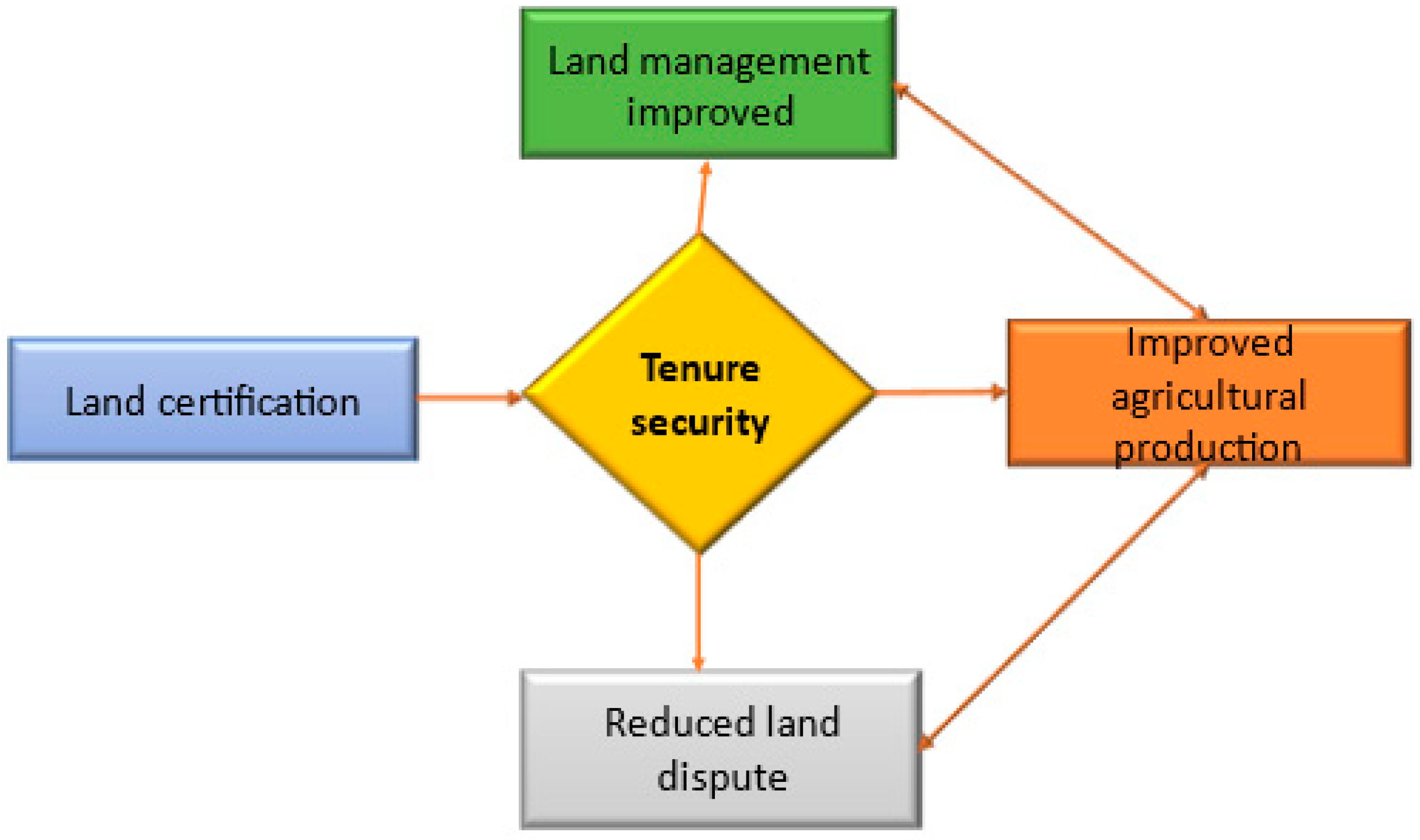
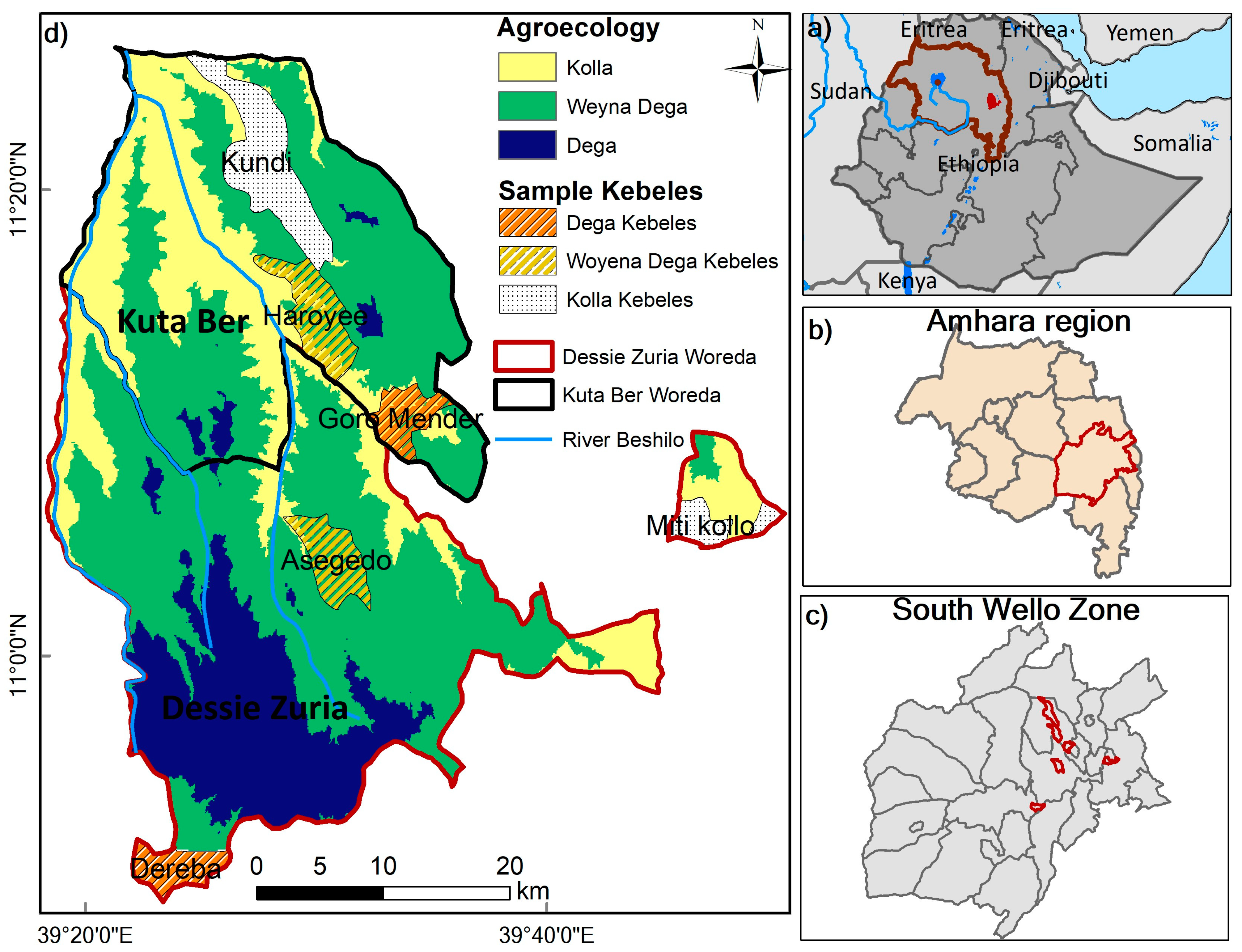


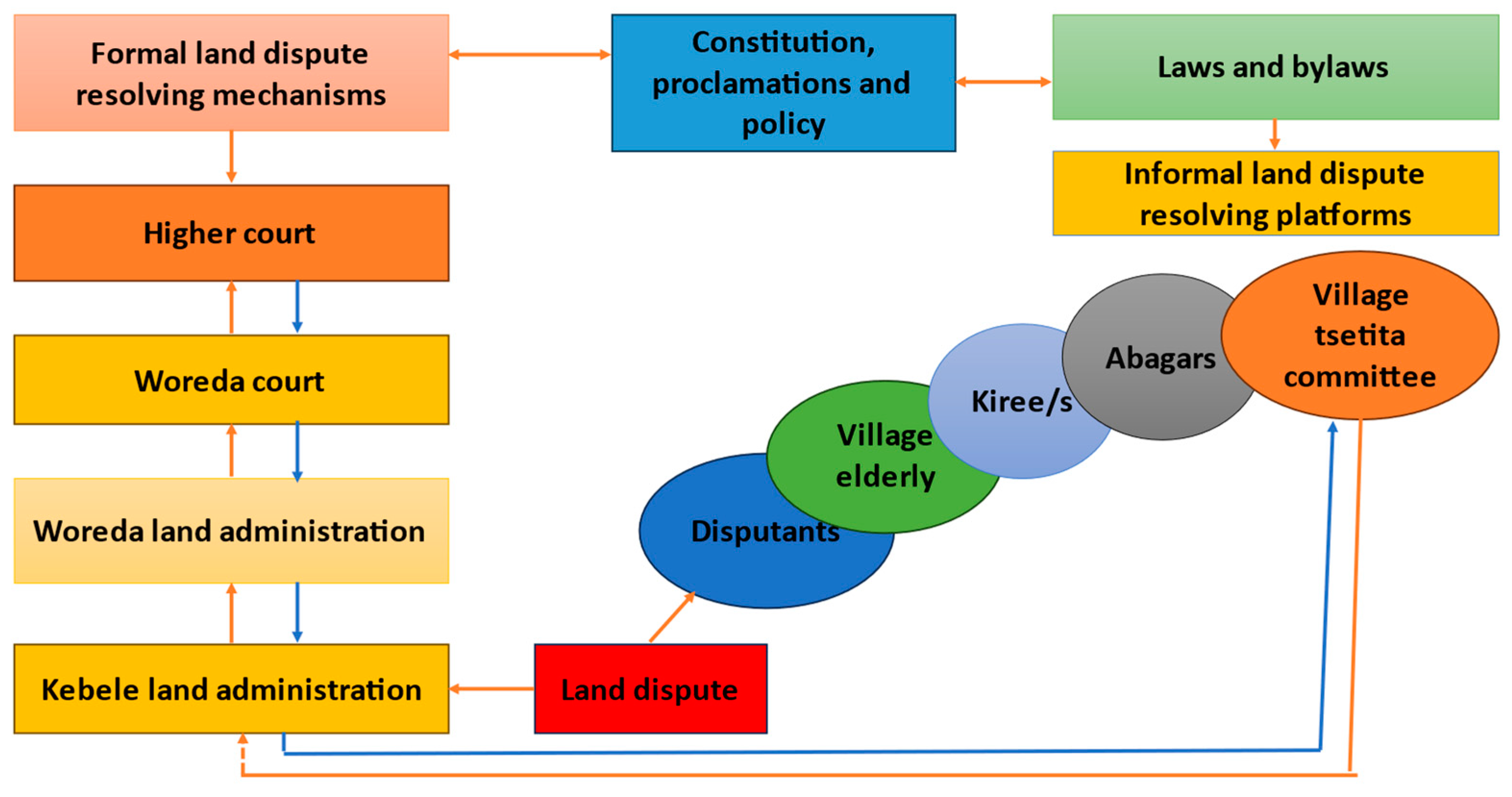
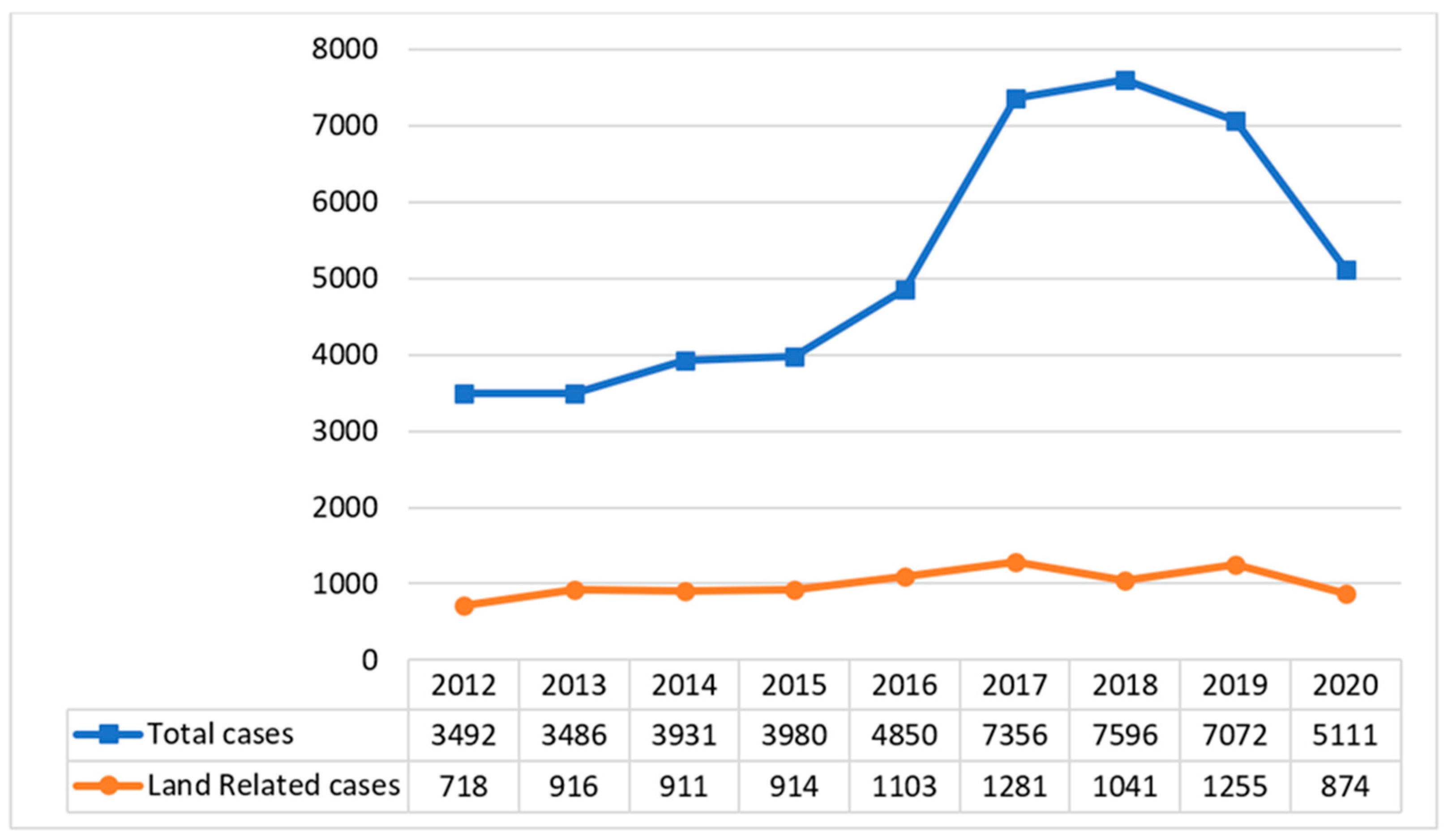
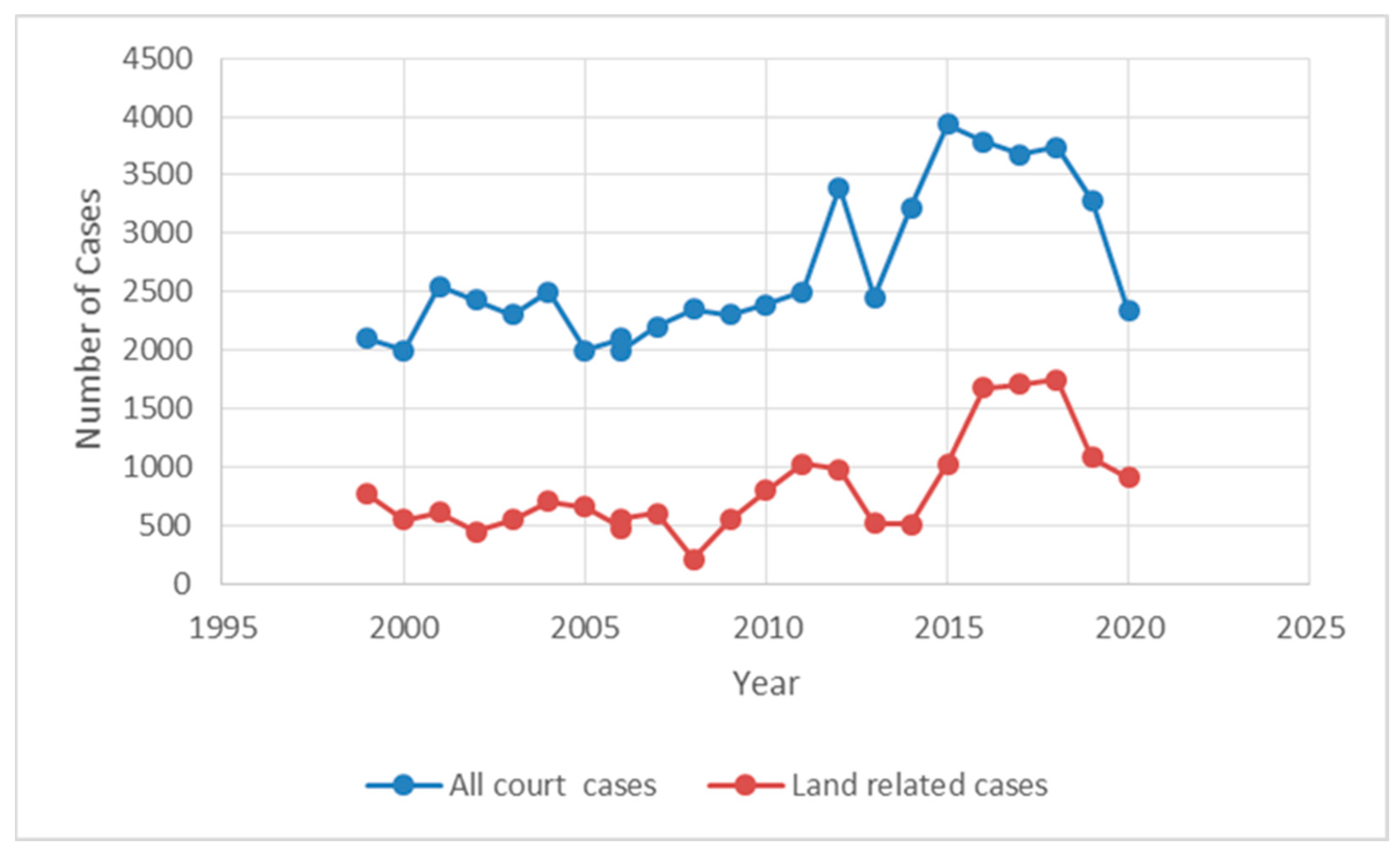

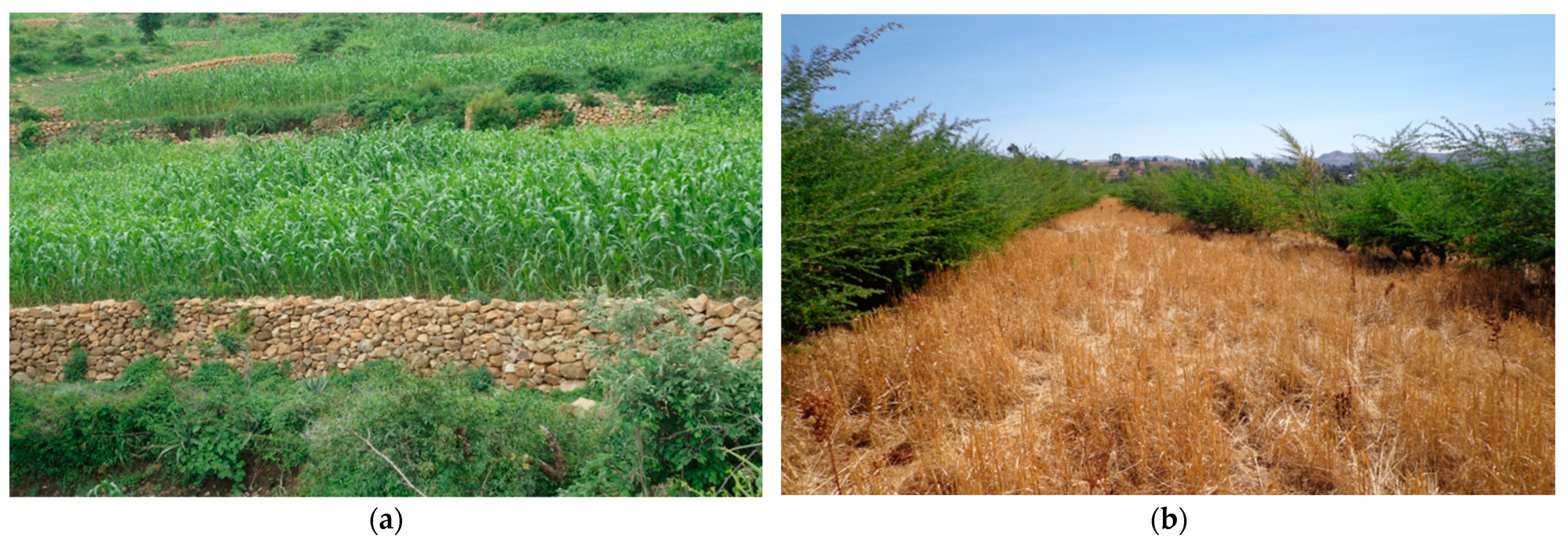
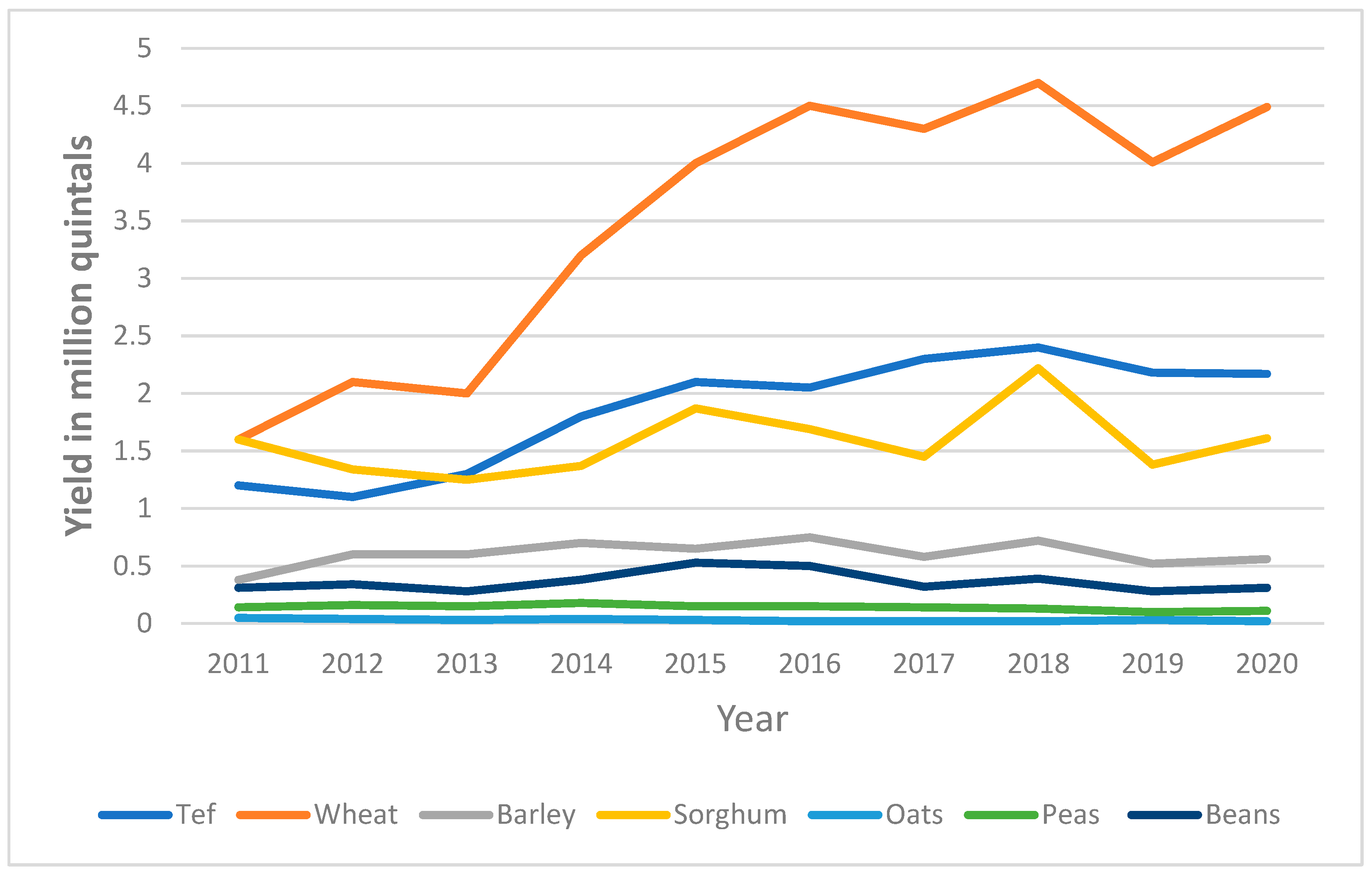
| (a) Gender | |||
| Woreda | Man | Woman | Total |
| Dessie Zuria | 123 | 34 | 157 |
| Kutaber | 201 | 43 | 244 |
| Total | 324 | 77 | 401 |
| (b) Education | |||
| Educational level | Frequency | percent | Cumulative frequency |
| Illiterate | 159 | 39.7 | 39.7 |
| Primary school | 168 | 42 | 81.6 |
| Secondary school | 74 | 18.4 | 100 |
| Total | 401 | - | - |
| (c) Family size | |||
| Male | Female | Total | |
| Dessie Zuria | 2.73 | 2.78 | 5.5 |
| Kutaber | 2.52 | 2.48 | 5.0 |
| Average | 2.62 | 2.63 | 5.25 |
| (d) Land size | |||
| Woreda | Average land size owned by household | No. of parcels | Average walking distances to farm plots in minutes |
| Dessie Zuria | 0.89 | 3.7 | 14.2 |
| Kutaber | 0.71 | 5.2 | 15 |
| Average | 0.77 | 4.45 | 14.6 |
| Year | Parcels Measured and Registered. (Number of Parcels) | Certificate Delivered |
|---|---|---|
| Until 2013 | 1,451,234 | 475,178 |
| 2014 | 359,816 | 97,772 |
| 2015 | 1,908,170 | 695,670 |
| 2016 | 4,393,635 | 1,252,999 |
| 2017 | 3,867,191 | 3,045,576 |
| 2018 | 9,219,904 | 5,632,805 |
| Total | 2,120,000 | 11,200,000 |
| Have You Received a Certificate for Your Plots? (n = 401) | ||||
|---|---|---|---|---|
| Woreda | Kebele | Yes | No | Total |
| Dessie Zuria | Dereba | 35 | 5 | 40 |
| Asgedo | 66 | 8 | 74 | |
| Serdom | 43 | 0 | 43 | |
| Kutaber | Goro Mendera | 64 | 4 | 68 |
| Haroyee | 38 | 9 | 47 | |
| Kundi | 125 | 4 | 129 | |
| Total | 371 | 30 | 401 | |
| (n = 371) | |||||
|---|---|---|---|---|---|
| Yes | Percent | No | Percent | Total | |
| Do you think having a certificate has a benefit? | 365 | 98.38 | 6 | 1.62 | 371 |
| Benefits of Land Certification | Estimation | Number of Obs. | 95 Percent | n = 365 |
|---|---|---|---|---|
| Std. | Err. | Conf. | ||
| Gender equity | 1450 | 19.56 | 1412 | 1488 |
| Tenure security | 1447 | 25.58 | 1397 | 1497 |
| Encourages SWC | 1334 | 16.71 | 1301 | 1367 |
| Reduces land disputes | 1335 | 25.92 | 1284 | 1386 |
| Better farming practice | 1174 | 23.14 | 1128 | 1220 |
| Promotes sharecropping | 982 | 25.73 | 931.4 | 1033 |
| A live fence between parcels | 955 | 23.66 | 908.5 | 1002 |
| Extended contractual agreement | 914 | 25.63 | 863.6 | 964.4 |
| Land plaguing practice | 820 | 22.74 | 775.3 | 864.7 |
| Better land renting trends | 813 | 22.93 | 767.9 | 858.1 |
| (n = 50) | |||||
|---|---|---|---|---|---|
| Types of Disputes | Std. | Err. | 95 Percent | Conf. | Interval |
| Spouses | 168 | 8.423 | 151.1 | 184.9 | |
| Waterways/cutoff drain | 159 | 9.761 | 139.4 | 178.6 | |
| Boundary | 147 | 8.380 | 130.2 | 163.8 | |
| Misinterpretation of plot information | 115 | 6.739 | 101.5 | 128.5 | |
| Bequest related | 110 | 7.559 | 94.81 | 125.2 | |
| Indicators | (n = 365) | |||
|---|---|---|---|---|
| Yes | Percent | No | Percent | |
| Adoption SWC practices | 270 | 74 | 104 | 26 |
| Extension service | 329 | 90.3 | 39 | 9.7 |
| Use of insecticide and pesticide | 71 | 19.5 | 323 | 80.6 |
| Use of improved seed | 188 | 51.6 | 194 | 48.4 |
| Use of fertilizer | 283.4 | 77.6 | 90 | 21.4 |
| (n = 365) | ||
|---|---|---|
| Amount of Compost Used/Household/in kg | Frequency | Percent |
| Non-users | 122 | 33.6 |
| <500 kg | 137 | 37.6 |
| 501–1000 kg | 52 | 14.2 |
| 1001–2500 kg | 24 | 6.5 |
| >2500 kg | 29 | 8.0 |
| Total | 365 | 100 |
Disclaimer/Publisher’s Note: The statements, opinions and data contained in all publications are solely those of the individual author(s) and contributor(s) and not of MDPI and/or the editor(s). MDPI and/or the editor(s) disclaim responsibility for any injury to people or property resulting from any ideas, methods, instructions or products referred to in the content. |
© 2023 by the authors. Licensee MDPI, Basel, Switzerland. This article is an open access article distributed under the terms and conditions of the Creative Commons Attribution (CC BY) license (https://creativecommons.org/licenses/by/4.0/).
Share and Cite
Tesfaye, B.; Lengoiboni, M.; Zevenbergen, J.; Simane, B. Rethinking the Impact of Land Certification on Tenure Security, Land Disputes, Land Management, and Agricultural Production: Insights from South Wello, Ethiopia. Land 2023, 12, 1713. https://doi.org/10.3390/land12091713
Tesfaye B, Lengoiboni M, Zevenbergen J, Simane B. Rethinking the Impact of Land Certification on Tenure Security, Land Disputes, Land Management, and Agricultural Production: Insights from South Wello, Ethiopia. Land. 2023; 12(9):1713. https://doi.org/10.3390/land12091713
Chicago/Turabian StyleTesfaye, Bichaye, Monica Lengoiboni, Jaap Zevenbergen, and Belay Simane. 2023. "Rethinking the Impact of Land Certification on Tenure Security, Land Disputes, Land Management, and Agricultural Production: Insights from South Wello, Ethiopia" Land 12, no. 9: 1713. https://doi.org/10.3390/land12091713
APA StyleTesfaye, B., Lengoiboni, M., Zevenbergen, J., & Simane, B. (2023). Rethinking the Impact of Land Certification on Tenure Security, Land Disputes, Land Management, and Agricultural Production: Insights from South Wello, Ethiopia. Land, 12(9), 1713. https://doi.org/10.3390/land12091713






